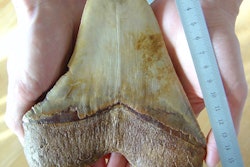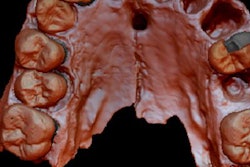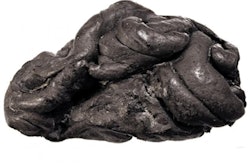
An infected 14,000-year-old tooth that was cleaned out with flint tools represents the oldest known dentistry, according to a study in Scientific Reports. The find represents the earliest archaeological example of a manual intervention on a pathological condition.
Prehistoric dental treatments were extremely rare, with a few documented cases from the Neolithic era, when early farming and an increase in carbohydrate-rich diets caused an increase in carious lesions, the researchers noted (Scientific Reports, July 16, 2015). The Neolithic era, also called the New Stone Age, was a period in the development of human technology, beginning about 10,200 B.C., and ending between 4,500 B.C. and 2,000 B.C.
Ancient Greeks and Romans had removed caries by drilling and cleaning the infected cavity, and Egyptian texts confirm this practice was done at least in the fifth century B.C., several studies show.
At the time, toothpicks probably made of bone or wood were used to remove food particles between teeth. The new study findings may show how early humans adopted the toothpicking technique to early forms of dentistry that included scratching caries using microlithic points.
In this study, an international team of researchers analyzed a lower right third molar from a well-preserved 25-year-old male skeleton found in 1988 in a burial site in Villabruna, Italy. They discovered a tooth that retains a large occlusal cavity with four carious lesions.
 Occlusal view of the right third molar. All images courtesy of Scientific Reports.
Occlusal view of the right third molar. All images courtesy of Scientific Reports.What 'tools' were used
Using a scanning electron microscope, the researchers identified striations and associated extensive enamel chipping on the mesial wall of the cavity, which they suggested were made by pointed flint tools during scratching and levering activities while the young man was alive.
"Various scientific analyses confirm that the vast carious lesion found on the chewing surfaces of the lower right third molar was intentionally treated, probably to clean out the infected tissue, through the use of a stone tip that left deep streaks on tooth enamel around and inside the cavity," said Jacopo Moggi-Cecchi, an associate professor from the department of biology at the University of Florence, in a statement.
 Stereo microscopical image of right third molar with magnification of the cavity and of the region (elipse) containing the striations described.
Stereo microscopical image of right third molar with magnification of the cavity and of the region (elipse) containing the striations described.Experiments done on the enamel of three molars using wood, bone, and microlithic points confirmed the striations are characteristic of scratching and chipping. Microliths are small stone tools usually made of flint or chert, typically about a centimeter long and half a centimeter wide.
"The earliest dental caries manipulation entails an adaptation of the toothpicking technique from simple rubbing actions between interproximal teeth using probes made on bone/wood, to scratching/levering activities within the carious lesion using microlithic points," the authors wrote.
“Primitive forms of carious treatment in human evolution entail an adaptation of the well-known toothpicking for levering and scratching rather than drilling practices.”
The orientation of the individual traces within the cavity indicates that a variety of gestures and movements associated with the slicing of the tool edges in different directions were used, they noted. The marks were potentially made during back and forth, semicircular, levering, and scratching movements, according to the researchers.
Traces of residue in the cavity suggest that it was filled with a natural wax, possibly beeswax, which could have been found in the nearby area, they wrote.
The tooth enamel was partially rounded and polished due to chewing wear, indicating the treatment was done long before the young man died.
"This study suggests that primitive forms of carious treatment in human evolution entail an adaptation of the well-known toothpicking for levering and scratching rather than drilling practices," the authors wrote.
Oldest evidence
The finding predates the next-oldest evidence of dentistry by as much as 5,000 years. The discovery represents a key moment in the development of dental surgical practices, the authors wrote.
Beewax used for dental fillings were discovered in a 6,500-year-old human tooth from Slovenia, while dental drilling, likely to remove decayed tissue, was discovered in 9,000-year-old molars from a Neolithic graveyard in Pakistan.
"The Villabruna specimen represents, therefore, the oldest archaeological evidence of operative manual intervention on a pathological condition (caries), as indicated by the striations on the bottom of the carious pit, potentially to remove the caries and/or to reestablish antagonistic tooth function by removing food particles entrapped within the cavity," the study authors concluded.



















